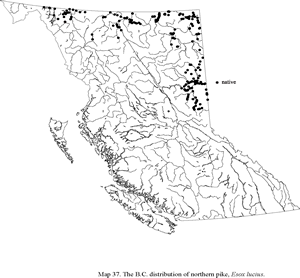Dorsal spines (total): 6 - 8; Dorsal soft rays (total): 17 - 25; Anal spines: 4 - 7; Anal soft rays: 10 - 22; Vertebrae: 57 - 65. Distinguished by its long, flat, 'duck-bill' snout; its large mouth with many large, sharp teeth; and the rearward position of its dorsal and anal fins (Ref. 27547). Gill rakers present only as patches of sharp teeth on gill arches; lateral line notched posteriorly (Ref. 27547). Dorsal located far to the rear; anal located under and arising a little behind dorsal; pectorals low on body, base under opercle; pelvic fins low on body; paired fins rounded, paddle-shaped (Ref. 27547). Caudal fin with 19 rays (Ref. 2196).
Source: FishBase. Crossman, E.J. 1996 Taxonomy and distribution. p. 1-11. In J.F. Craig (ed.) Pike biology and exploration. Chapman and Hall, London. 298 p.
